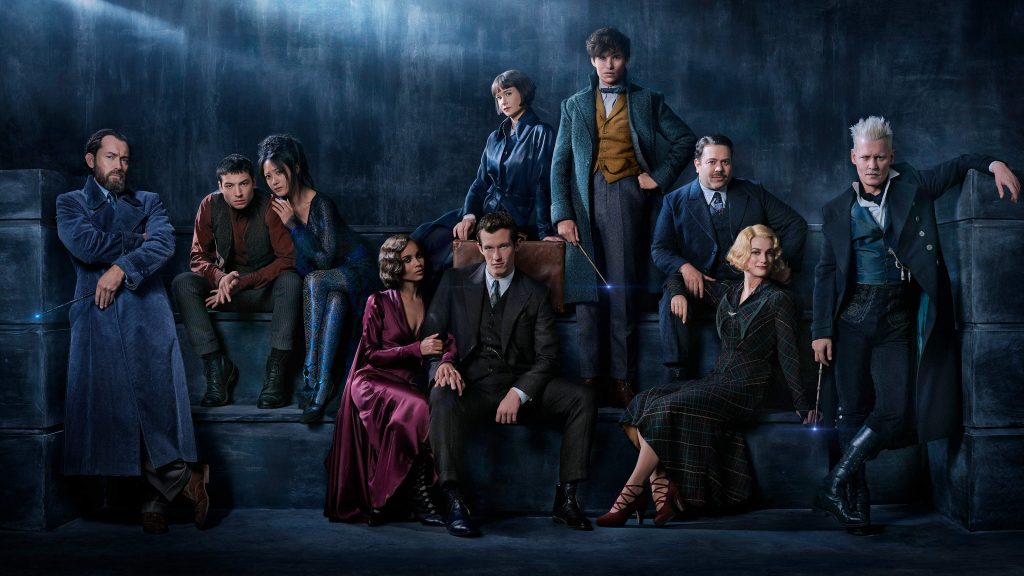The latest installment in the ‘Wizarding World’ franchise – ‘Fantastic Beasts: The Crimes of Grindelwald’, a direct sequel to ‘Fantastic Beasts and Where to Find Them’ (2016), is a delight mythology enthusiast, not for Harry Potter fans so much.
JK Rowling, who has penned the script to the Harry Potter spinoff, has however done a herculean task of interweaving high fantasy with the world of myth. The narrative is riddled with numerous allusions to elements from Greek/Roman, Norse, Celtic, Biblical, Japanese and Chinese Mythological folklore, with some scenes serving as allegories to the eyes of the keen observer. Below are a few notable mentions.
1. The Kappa makes an appearance: The scene introducing the audience to a human Nagini interacting with Credence Barebone, the possessor of the Obscurious, features a Kappa sitting in a bathtub filled with water. A water demon prevalent in Japanese Mythology, the Kappa is a supernatural creature believed to inhabit small water bodies. Usually depicted wearing a helmet-like headgear, (which was noticeably absent on-screen), which must be kept moist at all times, since legend has it that should Kappas venture out and stay away from water for an extended period of time, they might dehydrate and would be susceptible to physical harm.
2. The blood pact: Albus Dumbledore admits his inability to fight Gellert Grindelwald or oppose him directly in anyway owing to a blood pact between them, which is revealed later in the story. Similar to an unbreakable vow, a plot device native to Potterverse, the concept is somewhat similar – a binding contract between the participants that cannot be broken, the only way to be free of it is death. Its origins can be traced from the blood oaths mentioned in Norse Myths and Legends, most notable of which is the one that Norse Gods Odin and Loki entered, thus making them blood brothers. This pact between the deities was expanded upon in Joanne Harris’ 2014 book ‘The Gospel of Loki.’ Similarly, Neil Gaiman’s 2001 novel ‘American Gods’ witnesses a similar scenario when principal characters Mr. Wednesday (Odin again) and Shadow Moon, mutually agree to form a business partnership by drinking mead. It was a means for Wednesday to recruit Shadow as his bodyguard and hold his vigil in the case of the former’s untimely demise. Viking sagas contain blood oaths as a significant part of the storyline.
In order to take a blood oath, the concerned parties make a small cut on their respective hands and perform a handshake signifying their supposedly lifelong connection. In some cases, blood is mixed with a drink (wine or mead) which is then consumed. A vial containing droplets of blood presumably from Dumbledore and Grindelwald was shown in ‘Fantastic Beasts: The Crimes of Grindelwald.’
3. Grindelwald, a ‘Satanic’ trickster? Carrying on with Biblical allegories, ‘Crimes of Grindelwald’ expands upon the age-old battle between good and evil a la light vs darkness. Albus Dumbledore is portrayed as the epitome of virtue, who despite being unable to directly act against Gellert Grindelwald, goes out of his way to ensure the safety of the wizarding and non-wizarding worlds. Unlike Grindelwald, who displays fanatical ideals and wishes to establish a totalitarian governing order, Dumbledore, who is benevolent and compassionate, preaches equality for all.
Additionally, Grindelwald (Johnny Depp) who is seen here as the anti-thesis to the noble Dumbledore (Jude Law) is not just cruel and sadistic but also insincere, untrustworthy, a silver-tongued trickster with the ability to lie effectively and manages to influence or sway anyone without resorting to explicitly violent measures, which sets him apart from Voldemort, who suffered from pure blood mania and an obsession to attain immortality. He demonstrates this by succeeding in making Queenie Goldstein and Credence Barebone defect to his side.
During the rally to gather more followers at the cemetery containing the Lestrange Tomb in Paris, Grindelwald takes centerstage at a location, which resembles British artist John Martin’s painting ‘Satan Presiding at the Infernal Council’, an illustration from John Milton’s ‘Paradise Lost’, which was created between 1823 and 1827. One might think this would be fitting, since the struggle between Grindelwald and Dumbledore may be perceived as a parallel to the Bible’s War in Heaven, mentioned in The Book of Revelations. It tells the story of how Satan, identified as Lucifer, becomes enraged by God’s order that he bow before Man, who was created from humble clay. The being, who later becomes ‘The Devil’ proceeds to lead a group of rebel angels against the Almighty Lord in what would become a battle for supremacy. Opposing them are Archangel Michael and his fellow angels, who manage to defeat and cast them from heaven.
Both Grindelwald and Dumbledore can be identified as metaphorical equals to Michael and Satan here. The Durmstrang alumni, is shown to be persuasive and crafty, employing his cunning verbal skills and mind games to gain the trust of those he wishes to ultimately enslave, a ploy that the Devil uses countless times in several Biblical stories, most notably against Jesus Christ (in which he fails). A famous sculpture of a helmet-clad Michael carrying a sword and shield trampling a defeated Satan (termed as ‘The Dragon’ in the Holy scriptures) is most noteworthy.
Gellert Grindelwald is concerned with one thing: total world domination much like how the Devil attempts to entice humankind and other beings with the ability to reason into pledging allegiance to him until the end times, at least according to some sources. The motif of ‘picking a side’ in which the neutral Newt Scamander and Albus Dumbledore are implored to do so, seems to denote the aforementioned musings. What Grindelwald does different here is that he creates a false sense of security in the minds of people he wishes to entrap by convincing them that they are exercising their free will by choosing to join his cause.
The Celtic Myth cycle, especially Arthurian Folkore, dominates the proceedings: Albus Dumbledore’s character displays the traits of the ideal Celtic hero in a similar vein to King Arthur. He possesses kindness, benevolence, courage and chivalry among other notable qualities that embody the traditional protagonist of such folk tales and legends popular in Scotland, Wales and Ireland. He is also favourably compared to the sorceror Merlin, a mythical figure with immense magical skill, who was also a respected mentor to Arthur.
In fact, a strong Celtic stream of consciousness flows through the Harry Potter universe, especially seen in the motto of the House of Godric Gryffindor, which is essentially an expansion of what King Arthur had in mind, when forming the Round Table, since students with attributes like courage, nobility and righteousness were admitted.
All hail the mighty Zouwu: The formidable Zouwu, a dragon-like creature from Chinese Mythology is one of the ‘Fantastic Beasts’ in the film, which has been designed with feline features and is also wingless.
The name Theseus is of Greek origin: Auror Theseus Scamander, brother of reluctant protagonist Newt is named after the Greek hero Theseus, who was famous for slaying the horrible Minotaur, a monster with the head of a bull and a man’s body, after traversing the complicated labyrinth, a maze-like structure. It can be surmised that Theseus is adventurous like his mythical counterpart and also has the capability to exercise good judgment.
The Phoenix: The phoenix bird from the vivid tapestry of the Greek and Roman mythical world is an integral part of ‘Fantastic Beasts: The Crimes of Grindelwald’ as it is said by both Dumbledore and Grindelwald during different scenes that the phoenix appears to any Dumbledore, who is in dire need of assistance. It may have been a way to provide meat to the revelation of Credence Barebone’s identity as Aurelius Dumbledore at the end of the film.
Sidenotes: Queenie Goldstein is a skilled Legilimens so she may have an ulterior motive behind joining Grindelwald, and could actually be on the side of Newt and the others.
I am of the opinion that Credence is the son of Ariana Dumbledore. It was mentioned in ‘Deathly Hallows’ the seventh Harry Potter novel, that Ariana was attacked by a group of Muggle youths.
Rowling may have hinted at possible sexual assault but that’s open to interpretation for the reader. Also, I personally think this gives rise to several plot holes, as Ariana’s supposed subsequent pregnancy and the birth of Aurelius are events that would be too significant to hush up and then revealed later.
Lastly,
Credence: If he is indeed Aurelius Dumbledore, as Grindelwald told him, then there’s an additional problem. He is supposed to be 18 as per the current flow of the film’s timeline, and it would be difficult to establish him as Albus’ brother. Grindelwald, could also be lying as he did in the first film, when he told Credence that he was a talented wizard and later dismissed him as a squib as he was unaware that the latter was an Obscurial.


















